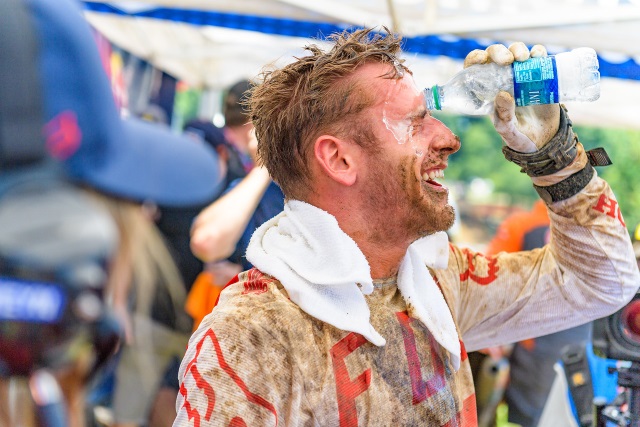
Sometimes we think, "just a little bit longer."
But the effects of heat stroke don't wait for the end of a Moto and when the symptoms of overheating begin, you have little time to reverse course.
Like thirst, often when riding dirt bikes we don't really know how hot our bodies have become until the symptoms of heat stroke hit. In fact, according to WebMD, heat stroke can occur suddenly and without any symptoms. Therefore, when riding dirt bikes whether on the tracks or trail no one can tell you to stop - you have to make a decision based on knowing your body and recognizing your limits.
Heat related issues affect the body in a number of ways sometimes starting with cramps and heavy sweating to vomiting and passing out. Therefore, tuning in to your body, understanding the symptoms of overheating and recognizing those symptoms prevents lasting damage and even death.
Generally, heat exhaustion occurs first and after a period of time leads to heat stroke. Both incur many of the same warning signs so it becomes important to differentiate and identify normal exhaustion from hard riding and crossing the line to heat illness symptoms that leads down a critical road. Experiencing heat exhaustion or heat stroke can change your life with long lasting effects so be wary of anything that feels abnormal impacts your ability to ride.
Heat Exhaustion Symptoms
WebMD details the most common signs of heat exhaustion which include:
- Confusion
- Dark-colored urine (a sign of dehydration)
- Dizziness
- Fainting
- Fatigue
- Headache
- Muscle or abdominal cramps
- Nausea, vomiting, or diarrhea
- Pale skin
- Profuse sweating
- Rapid heartbeat
Heat Stroke Symptoms
And, WebMD states the signs of heat stroke include:
- Nausea and vomiting
- Headache
- Dizziness or vertigo
- Fatigue
- Hot, flushed, dry skin
- Rapid heart rate
- Dry skin
- Profound sweating
- Shortness of breath
- Decreased urination
- Blood in urine or stool
- Increased body temperature (104 degrees to 106 degrees F)
- Confusion, delirium, or loss of consciousness
- Convulsions
Preventing Heat Exhaustion and Heat Stroke
Check the Weather
If you plan on riding in hot weather be on the alert. You will far more likely experience issues related to overheating when riding in 90 degree sun than 60 degrees and cloudy. Don't underestimate the impact of hot weather especially when racing Motocross.
You also don't want to remove some riding protection as a way to keep cool, either. You still need helmet, gloves, goggles, chest protector and all the usual riding gear. Instead, recognize your vulnerability when riding in hot weather especially if you have never experienced the symptoms of heat related illness. All that gear probably feels more like wearing a down quilt so try putting on cooling garments underneath your regular gear. Adding additional clothing sounds counterproductive but some cooling vests for example soaked in water prior to wearing and helps keep you cool for up to 10 hours. Check out some additional cooling garments.
Train Well
Though genetics help (or don't help), one reason why some riders easily finish a Moto without succumbing to the heat comes from training. Would you train for a sand track on hard-packed clay? Of course not. Therefore, preparing your body for riding rigorously in the heat helps immeasurably to combat issues that come with heat exhaustion and stroke. Your body will manage the heat better if you get more accustomed not only to hot weather, but riding and training in hot weather.
Hydrate
Drink water in the days leading to your ride or race day, drink water before the gate drop, drink water in between Motos and drink water afterwards. Water keeps you cool and dehydration prevents your natural air-conditioning from working, i.e. sweat, thus you cannot adequately reduce your body temperature. Read How to Stay Hydrated on the Motocross Track for tips on keeping adequate fluids in your body.
Keep Cool
Get away from the sun, use an umbrella while waiting for the gate drop then afterwards, if needed, strip down to your skivvies, jump in a cool bath or drench yourself with water. Do whatever it takes to externally cool your body off to help get your internal temperature down.
Always play it safe. If you feel fatigued or sick during a ride or even just hot and uncomfortable which affects your ability to ride, pull off, cool down and if it means calling it a day then do so.









